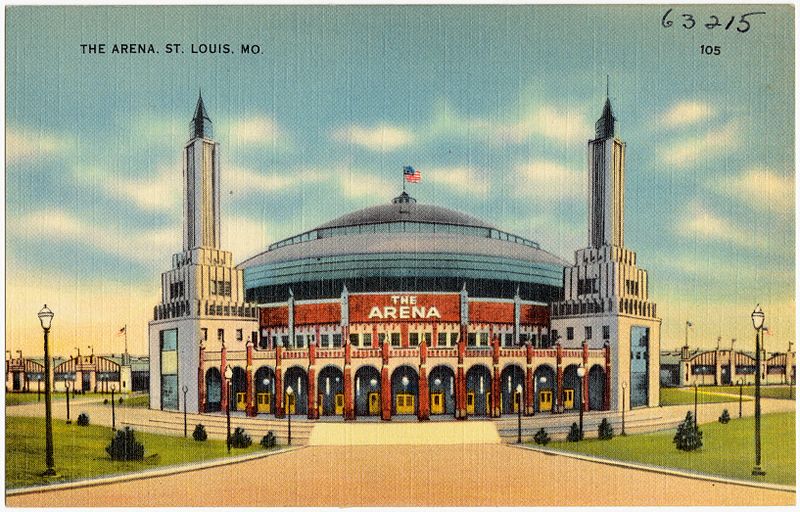- Home
- Hockey Resources
- St. Louis Arena (Checkerdome)
St. Louis Arena (Checkerdome)

One of the knocks against modern sports arenas is they are so generic: If you’ve seen one, you’ve seen them all. If there’s one thing you can say about St. Louis Arena — also known as St. Louis Checkerdome from 1977 to 1983 — is that it had character. Home ice for the St. Louis Blues from the team’s formation in 1967 until 1994, the Checkerdome not only had character in terms of history, architecture and design, it played host to some exciting hockey and boasted some of the best sight lines of any NHL arena. Furthermore, it was so loud and boisterous that opposing teams dreaded making a visit. Nicknamed “The Barn” and “The Old Barn” by St. Louis hockey fans (it was a barn, kind of, to begin with), St. Louis Arena was a unique NHL venue that will never be replicated.
St. Louis Arena/St. Louis Checkerdome — History
St. Louis Arena opened in 1929, just before the stock market crash. It was designed as an all-purpose arena that over the years hosted sporting events, circuses, political conventions, concerts, horse shows and roller derby. Early, St. Louis Arena was home to the National Dairy Show and had a dirt floor for about 15 years. It has been reported that the odor of cattle stuck to the arena throughout the Blues era, adding to the venue’s character, if not its atmosphere.
In the 1950s, a tornado swept through St. Louis and tore off part of the arena’s roof, after which time the arena was not well maintained until the St. Louis Blues were to become tenants. Blues owner Sid Salomon Jr. acquired the facility from the Chicago Black Hawks (now Blackhawks) organization and added seats to increase the hockey seating capacity from 12,000 to about 15,000. Renovations would continue over the next several years to eventually bring the capacity to 20,000 in 1994.
The name of the arena was changed to Checkerdome when Ralston Purina bought the Blues and the stadium in 1977. When the company sold these assets in 1983, the new owner, Harry Ornest, reverted to the original name, St. Louis Arena.
The exterior of St. Louis Arena was a giant sphere, with a series of arches around the front at the bottom and two towers projecting from either side. On the inside, the structure was supported with steel trusses, eliminating the need for view-obscuring pillars. Thus, even though St. Louis Arena was not originally designed for hockey, it proved to be a near-perfect design for this fast-moving game. The climb to upper-level seats was notably steep; it was hard to make it without holding the rail, but at least when a fan scaled the heights, the view was worth the trip. The lack of pillars may have put opposing teams on edge when the notoriously loud and aggressive Blues fans roared, causing the structure to rumble and shake.
Surprisingly, the St. Louis Blues were not the first hockey team or even the first NHL team to call St. Louis Arena home:
- The St. Louis Flyers, an AHA and AHL team, called St. Louis Arena home from 1929-1953. The team won five AHA titles in the late 1930s-early 1940s.
- The Chicago Black Hawks played at the arena from time to time during the 1950s.
- The St. Louis Braves, a CHL team affiliated with the Black Hawks, called the arena home from 1963 until 1967, when the Blues arrived.
The Blues played at St. Louis Arena until 1994, moving to Kiel Center, which is now called Enterprise Center. St. Louis Arena, with no revenue-generating potential, was demolished in 1999, despite strong opposition from local hockey fans and other St. Louis residents.
(Image Credit – Wikimedia Commons)
/div> Loading... Please wait...
Loading... Please wait...


